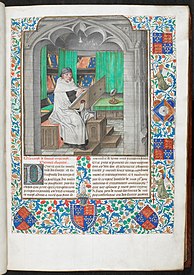In literary theory, a text is any object that can be "read", whether this object is a work of literature, a street sign, an arrangement of buildings on a city block, or styles of clothing.[citation needed] It is a set of signs that is available to be reconstructed by a reader (or observer) if sufficient interpretants are available.[citation needed] This set of signs is considered in terms of the informative message's content, rather than in terms of its physical form or the medium in which it is represented.[citation needed]
Within the field of literary criticism, "text" also refers to the original information content of a particular piece of writing; that is, the "text" of a work is that primal symbolic arrangement of letters as originally composed, apart from later alterations, deterioration, commentary, translations, paratext, etc. Therefore, when literary criticism is concerned with the determination of a "text", it is concerned with the distinguishing of the original information content from whatever has been added to or subtracted from that content as it appears in a given textual document (that is, a physical representation of text).
Since the history of writing predates the concept of the "text", most texts were not written with this concept in mind. Most written works fall within a narrow range of the types described by text theory. The concept of "text" becomes relevant if and when a "coherent written message is completed and needs to be referred to independently of the circumstances in which it was created."[citation needed]





